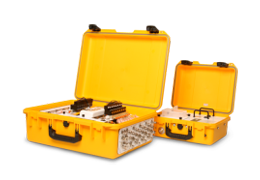NOTE: Read "Using CO2 and H2O Scrubbers with LI-COR Gas Analyzers" for important information about the interactions between scrub chemicals and the air. See https://licor.app.boxenterprise.net/s/7i418s3uhd2uamoxfmjd.
- Plumb the LI-8100A. See Figure 7‑1 for tank gas and Figure 7‑2 for scrubbers.
- If you are using tank gas, use a flow splitter to vent the excess gas to the atmosphere. Turn the instrument pump on and set flow from the tank to 2 to 2.5 lpm. Vent the instrument outlet to the atmosphere to prevent pressurizing the analyzer. If you are using chemical scrubbers, plumb everything and then turn the instrument pump on.

- Figure 7‑1. Typical plumbing configuration for setting the instrument zero using a zero gas. Always use dry, CO2-free air.

- Figure 7‑2. Typical plumbing configuration for setting the instrument zero using gas scrubbers. Soda lime and Ascarite II® are good CO2 scrubbers. Drierite® and magnesium perchlorate are good water vapor scrubbers.
- Monitor CO2 and H2O concentra`tions. Allow 1-2 minutes for the CO2 concentrations to stabilize and 15-20 minutes for the H2O concentration to stabilize near zero.
- Calibrate:
![]()
In the PC Software:
Configure the Data view to show CO2 (µmol/mol) and H2O (mol/mol); (click a variable to change it).
Go to Utilities > Calibration and go to the Zero tab.
When H2O concentrations are stable, click Zero H2O.
When the CO2 concentration is stable, click Zero CO2.
![]()
In the App:
Go to Utilities > Calibration, then tap Perform: Zero.
Under the CO2 tab, tap Send Command when the CO2 reading is stable.
Under the H2O tab, tap Send Command when the H2O reading is stable.
